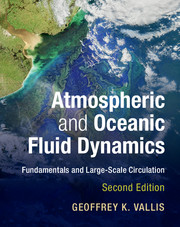Book contents
- Frontmatter
- Dedication
- Contents
- Preface
- Notation
- PART I FUNDAMENTALS OF GEOPHYSICAL FLUID DYNAMICS
- PART II WAVES, INSTABILITIES AND TURBULENCE
- PART III LARGE-SCALE ATMOSPHERIC CIRCULATION
- PART IV LARGE-SCALE OCEANIC CIRCULATION
- 19 Wind-Driven Gyres
- 20 Structure of the Upper Ocean
- 21 The Meridional Overturning Circulation and the acc
- 22 Equatorial Circulation and El Niño
- References
- Index
22 - Equatorial Circulation and El Niño
from PART IV - LARGE-SCALE OCEANIC CIRCULATION
Published online by Cambridge University Press: 09 June 2017
- Frontmatter
- Dedication
- Contents
- Preface
- Notation
- PART I FUNDAMENTALS OF GEOPHYSICAL FLUID DYNAMICS
- PART II WAVES, INSTABILITIES AND TURBULENCE
- PART III LARGE-SCALE ATMOSPHERIC CIRCULATION
- PART IV LARGE-SCALE OCEANIC CIRCULATION
- 19 Wind-Driven Gyres
- 20 Structure of the Upper Ocean
- 21 The Meridional Overturning Circulation and the acc
- 22 Equatorial Circulation and El Niño
- References
- Index
Summary
EQUATORIAL OCEANOGRAPHY DECEIVES US, hiding fascinating, non-intuitive dynamics beneath the languorous tropical air. The mid-latitudes give us the great gyres with their intense western boundary currents and mesoscale eddies, and by comparison the equatorial currents may seem, on the surface, featureless and vapid. Yet the equatorial regions are home to the resolute equatorial undercurrents that tunnel across the basins, opposite in bearing to the winds that drive them. And the equatorial ocean and atmosphere — in a collaboration that is more tango than waltz — give rise to the marvellous phenomenon that is El Niño, the most dramatic example of climate variability on human timescales that this planet has to offer. Such phenomena are the subjects of this chapter.
The defining feature of equatorial dynamics is that the Coriolis parameter becomes small, at least by comparison with the mid-latitudes, and balanced and unbalanced dynamics become intertwined, as we encountered in Chapter 8. Yet if we move more than a few degrees away from the equator the Rossby number again becomes quite small, suggesting that familiar ways of investigating the dynamics — Sverdrup balance for example — might yet play a role. Let's first see what we are trying to understand and if the observations can give us some intuition.
OBSERVATIONAL PRELIMINARIES
In mid-latitudes the gyres are very robust features, existing in all the basins, and may be understood as the direct response to the curl of the wind stress. In the equatorial regions the currents also display some robust and distinctive features, illustrated in Fig. 22.1 and the top panel of Fig. 22.2, but their relation to the winds is less obvious. The main features are as follows:
1. A shallow westward flowing surface current, typically confined to the upper 50 m or less, strongest within a few degrees of the equator, although not always symmetric about the equator. Its speed is typically a few tens of centimetres per second.
2. A strong coherent eastward undercurrent extending to about 200 m depth, confined to within a few degrees of the equator. Its speed is up to a metre per second or a little more, and it is this current that dominates the vertically integrated transport at the equator. Beneath the undercurrent the flow is relatively weak.
- Type
- Chapter
- Information
- Atmospheric and Oceanic Fluid DynamicsFundamentals and Large-Scale Circulation, pp. 861 - 908Publisher: Cambridge University PressPrint publication year: 2017



